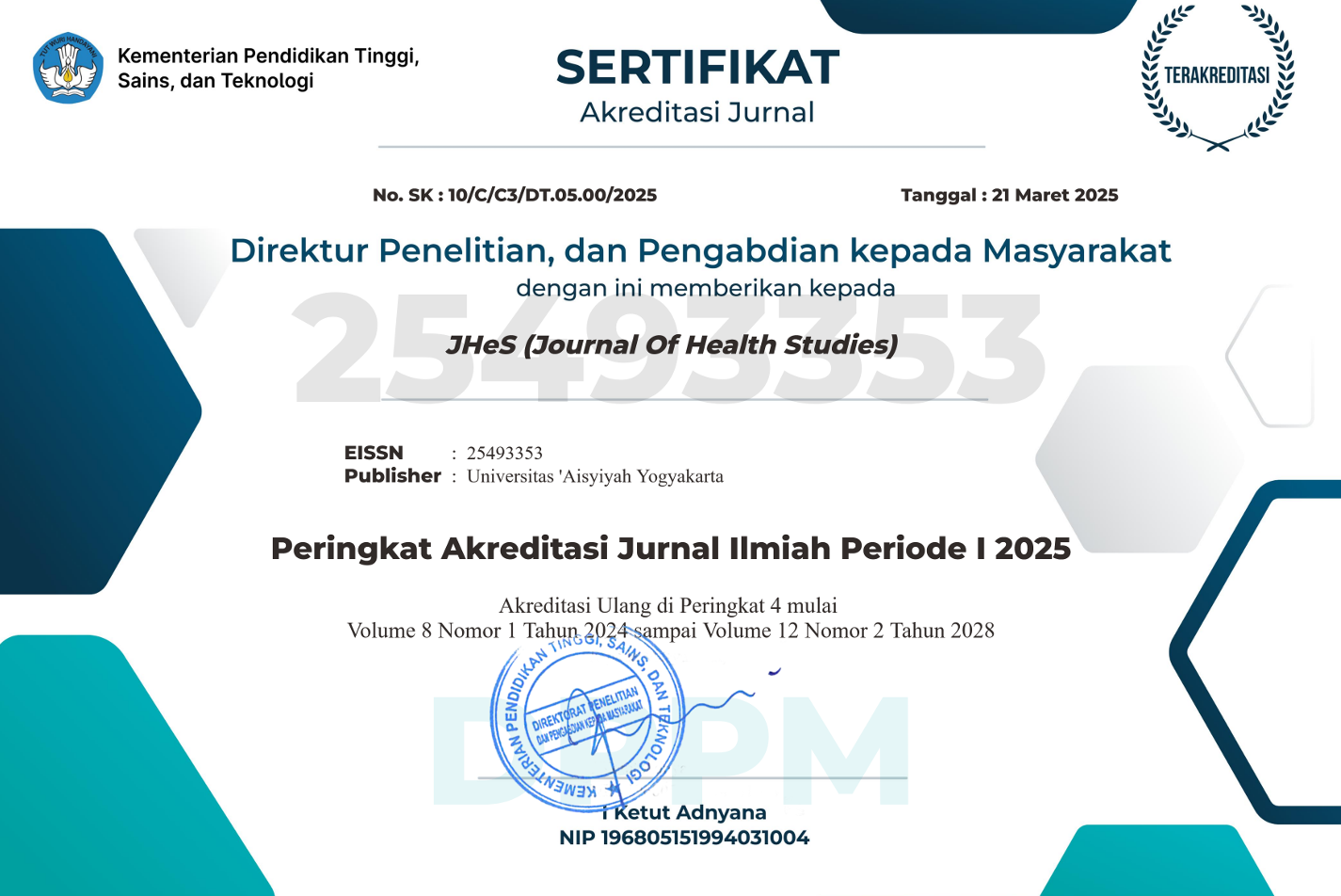Risk analysis of PM2.5 exposure among workers at railway station
DOI:
https://doi.org/10.31101/jhes.3877Abstract views 308 times
Keywords:
air quality, health risk, PM2.5, train stationAbstract
Downloads
References
Abidin, A. U., Maziya, F. B., Susetyo, S. H., Yoneda, M., & Matsui, Y. (2023). Exposure particulate matter (PM2.5) and health risk assessment on informal workers in landfill site, Indonesia. Environmental Challenges, 13(November), 100795. https://doi.org/10.1016/j.envc.2023.100795
Allouche, Y., Fadel, M., Ferté, A., Verdin, A., Ledoux, F., & Courcot, D. (2024). Phenomenology of the Composition of PM2.5 at an Urban Site in Northern France. Atmosphere, 15(5), 0–24. https://doi.org/10.3390/atmos15050603
Andriani, S., & Wahyuni, N. (2021). Kualitas Udara Dalam Ruangan Sekolah (PM2.5, PM10, CO2, Dan HCHO) dan Risiko Kesehatan pada Siswa di Kota Serang. Journal of Baja Health Science, 1(02), 141–155. https://doi.org/10.47080/joubahs.v1i02.1486
Ardhaneswari, M., & Wispriyono, B. (2022). Analisis Risiko Kesehatan Akibat Pajanan Senyawa Nitrat dan Nitrit Pada Air Tanah di Desa Cihambulu Subang. Jurnal Kesehatan Lingkungan Indonesia, 21(1), 65–72. https://doi.org/10.14710/jkli.21.1.65-72
Aziza, N., Rahardjo, M., & Budiyono, B. (2020). Kadar Debu Terhirup dan Gangguan Fungsi Paru pada Masyarakat di sekitar Stasiun Tawang Semarang. Media Kesehatan Masyarakat Indonesia, 19(4), 304–310. https://doi.org/10.14710/mkmi.19.4.304-310
BBLabkesmas Yogyakarta. (2023). Identifikasi Risiko dan Dampak Bencana/Pencemaran Lingkungan Terhadap Masyarakat Bersumber Udara di Stasiun Yogyakarta Kota Yogyakarta.
Chang, L., Chong, W. T., Yau, Y. H., Cui, T., Wang, X. R., Pei, F., Liu, Y. Q., & Pan, S. (2024). An investigation of the PM2.5 concentrations and cumulative inhaled dose during subway commutes in Changchun, China. International Journal of Environmental Science and Technology, 21(1), 733–746. https://doi.org/10.1007/s13762-023-04994-7
Chen, Q., Wang, Y., Yang, L., Sun, L., Wen, Y., Huang, Y., Gao, K., Yang, W., Bai, F., Ling, L., Zhou, Z., Zhang, X., Xiong, J., & Zhai, R. (2022). PM2.5 promotes NSCLC carcinogenesis through translationally and transcriptionally activating DLAT-mediated glycolysis reprogramming. Journal of Experimental and Clinical Cancer Research, 41(1), 1–21. https://doi.org/10.1186/s13046-022-02437-8
Dettori, M., Deiana, G., Balletto, G., Borruso, G., Murgante, B., Arghittu, A., Azara, A., & Castiglia, P. (2021). Air pollutants and risk of death due to COVID-19 in Italy. Environmental Research, 192(October 2020), 110459. https://doi.org/10.1016/j.envres.2020.110459
Ejohwomu, O. A., Oladokun, M., Oshodi, O. S., Bukoye, O. T., Edwards, D. J., Emekwuru, N., Adenuga, O., Sotunbo, A., Uduku, O., Balogun, M., & Alani, R. (2022). The Exposure of Workers at a Busy Road Node to PM2.5: Occupational Risk Characterisation and Mitigation Measures. International Journal of Environmental Research and Public Health, 19(8). https://doi.org/10.3390/ijerph19084636
Fisher, S., Bellinger, D. C., Cropper, M. L., Kumar, P., Binagwaho, A., Koudenoukpo, J. B., Park, Y., Taghian, G., & Landrigan, P. J. (2021). Air pollution and development in Africa: impacts on health, the economy, and human capital. The Lancet Planetary Health, 5(10), e681–e688. https://doi.org/10.1016/S2542-5196(21)00201-1
Fruhwirt, D., Sturm, P., Nöst, T., Leonhardt, P., Bode, G., Michael, S., & Rodler, J. (2023). PM emissions from railways – Results of tests on a wheel-rail test bench. Transportation Research Part D: Transport and Environment, 122(August). https://doi.org/10.1016/j.trd.2023.103858
Geng, G., Zheng, Y., Zhang, Q., Xue, T., Zhao, H., Tong, D., Zheng, B., Li, M., Liu, F., Hong, C., He, K., & Davis, S. J. (2021). Drivers of PM2.5 air pollution deaths in China 2002–2017. Nature Geoscience, 14, 645–650.
Hu, S., Zhao, W., Han, C., Yi, K., Chen, S., & Zheng, J. (2024). Measurement and analysis of the air quality within a high-speed train carriage in a region of Southwest China. E3S Web of Conferences, 512. https://doi.org/10.1051/e3sconf/202451203016
IQAir. (2023). World Air Quality Report 2023. In IQAir.
IQAir. (2024). Kualitas Udara di DI Yogyakarta. Indeks Kualitas Udara (AQI). https://www.iqair.com/id/indonesia/yogyakarta
Kodros, J. K., O’Dell, K., Samet, J. M., L’Orange, C., Pierce, J. R., & Volckens, J. (2021). Quantifying the Health Benefits of Face Masks and Respirators to Mitigate Exposure to Severe Air Pollution. Geohealth, 5(9). https://doi.org/https://doi.org/10.1029%2F2021GH000482
Latifah, I., Gusti, A., & Pristi Rahmah, S. (2021). Analisis Risiko Kesehatan Lingkungan (ARKL) Pajanan PM2.5 Pada Siswa Di SD N 28 Mandau Duri Riau Tahun 2020. Jurnal Keselamatan Kesehatan Kerja Dan Lingkungan, 2(1), 1–10. https://doi.org/10.25077/jk3l.2.1.1-10.2021
Lelieveld, J., Haines, A., Burnett, R., Tonne, C., Klingmüller, K., Münzel, T., & Pozzer, A. (2023). Air pollution deaths attributable to fossil fuels: Observational and modelling study. Bmj, 1–10. https://doi.org/10.1136/bmj-2023-077784
Li, C., & Managi, S. (2021). Contribution of on-road transportation to PM2.5. Scientific Reports, 11(1), 1–13. https://doi.org/10.1038/s41598-021-00862-x
Liao, N. S., Sidney, S., Deosaransingh, K., Van Den Eeden, S. K., Schwartz, J., & Alexeeff, S. E. (2021). Particulate air pollution and risk of cardiovascular events among adults with a history of stroke or acute myocardial infarction. Journal of the American Heart Association, 10(10). https://doi.org/10.1161/JAHA.120.019758
Maksum, T. S., & Tarigan, S. F. N. (2022). Analisis Risiko Kesehatan Akibat Paparan Partikel Debu (PM2.5) dari Aktivitas Transportasi. Jambura Health and Sport Journal, 4(1), 19–28. https://doi.org/10.37311/jhsj.v4i1.13447
Mantilla, J. M. D., Núñez, D. O., & Vogt, L. (2023). Analysis of particulate matter emissions from rail traffic during braking cycles with emphasis on particle size distribution, ultrafine particles and black carbon emissions. 7th International Symposium WASTE Club Stuttgart e.V., December. https://doi.org/10.5281/zenodo.10243481
McDuffie, E. E., Martin, R. V., Spadaro, J. V., Burnett, R., Smith, S. J., O’Rourke, P., Hammer, M. S., van Donkelaar, A., Bindle, L., Shah, V., Jaeglé, L., Luo, G., Yu, F., Adeniran, J. A., Lin, J., & Brauer, M. (2021). Source sector and fuel contributions to ambient PM2.5 and attributable mortality across multiple spatial scales. Nature Communications, 12(1), 1–12. https://doi.org/10.1038/s41467-021-23853-y
Meng, F., Wang, J., Li, T., & Fang, C. (2020). Pollution Characteristics, Transport Pathways, and Potential Source Regions of PM2.5 and PM10 in Changchun City in 2018. International Journal of Environmental Research and Public Health, 17(18), 1–19. https://doi.org/10.3390/ijerph17186585
Nääv, Å., Erlandsson, L., Isaxon, C., Åsander Frostner, E., Ehinger, J., Sporre, M. K., Krais, A. M., Strandberg, B., Lundh, T., Elmér, E., Malmqvist, E., & Hansson, S. R. (2020). Urban PM2.5 Induces Cellular Toxicity, Hormone Dysregulation, Oxidative Damage, Inflammation, and Mitochondrial Interference in the HRT8 Trophoblast Cell Line. Frontiers in Endocrinology, 11(March), 1–11. https://doi.org/10.3389/fendo.2020.00075
Nur, E., Seno, B. A., & Hidayanti, R. (2021). Risiko Gangguan Kesehatan Masyarakat Akibat Pajanan PM10 di Kota Padang. 20(November 2019), 97–103.
Nurfadillah, A. R., & Petasule, S. (2022). Environmental Health Risk Analysis (SO2, NO2, CO and TSP) in The Bone Bolango Area Road Segment. Journal Health & Science : Gorontalo Journal Health and Science Community, 6(2), 76–89. https://doi.org/10.35971/gojhes.v5i3.13544
Pangestika, R., & Wilti, I. R. (2021). Karakteristik Risiko Kesehatan Non-Karsinogenik Akibat Pajanan PM 2,5 di Tempat-Tempat Umum di Jakarta. Jurnal Kesehatan Lingkungan Indonesia, 20(1), 7–14.
Poothong, W., Sirinam, K., Nuchbua, P., Pothidok, N., Viriyanukul, P., Athikankowit, O., Klongnarong, A., Santad, C., Busayarat, C., Janjamlha, T., & Sudprasert, S. (2020). Study of PM2.5 Filtering by Using Climbing Plant Attached to an Architecture. Built, 15, 7–16. https://doi.org/10.14456/built.2020.1
Priyan, S., Guo, Y., McNabola, A., Broderick, B., Caulfield, B., O’Mahony, M., & Gallagher, J. (2024). Detecting and quantifying PM2.5 and NO2 contributions from train and road traffic in the vicinity of a major railway terminal in Dublin, Ireland. Environmental Pollution, 361(2). https://doi.org/10.1016/j.envpol.2024.124903
Przybyla, J., Buser, M. C., Abadin, H. G., & Pohl, H. R. (2020). Evaluation of ATSDR’s MRL and EPA’s RfCs/RfDs: Similarities, Differences, and Rationales. Journal of Toxicology and Pharmacology, 4(1), 1. /pmc/articles/PMC10300620/%0A/pmc/articles/PMC10300620/?report=abstract%0Ahttps://www.ncbi.nlm.nih.gov/pmc/articles/PMC10300620/
Quarmby, S., Santos, G., & Mathias, M. (2019). Air quality strategies and technologies: A rapid review of the international evidence. Sustainability (Switzerland), 11(10), 1–18. https://doi.org/10.3390/su11102757
Ridayanti, D. D. P., Khambali, & Suryono, H. (2022). Risiko Paparan Debu/Particulate Matter (PM2,5) Terhadap Kesehatan Masyarakat (Studi Kasus: Tempat Pembuatan Batu Bata di Desa Kaloran, Kecamatan Ngronggot, Nganjuk). Penelitian Kesehatan Suara Forikes, 13(April), 1–7.
Rivai, A., Ahmad, H., Rasman, Inayah, & Febriyanti. (2021). Levels of Particulate Matter 2.5 ( PM2.5 ) on Potential Respiratory Disorders in Traders Around the Road of Sultan Alauddin Makassar City. Urban Health, 3(1), 165–171. http://journal.poltekkes-mks.ac.id/ojs2/index.php/Prosiding/article/download/2497/1720
Rosalia, O., Wispriyono, B., & Kusnoputranto, H. (2018). Karakteristik Risiko Kesehatan Non Karsinogen pada Remaja Siswa Characteristic of Health Risks on Students Due to Dust Inhalation Debu Particulate Matter <2,5 (PM2,5). Jurnal MKMI, 14(1), 26–35.
Rowland, N., McVicar, D., Vlachos, S., Jahanshahi, B., McGovern, M. E., & O’Reilly, D. (2024). Long-term exposure to ambient PM2.5 and population health: evidence from linked census data. Economics and Human Biology, 55(July). https://doi.org/10.1016/j.ehb.2024.101417
Ryu, J., Kim, J. J., Byeon, H., Go, T., & Lee, S. J. (2018). Removal of fine particulate matter (PM2.5) via atmospheric humidity caused by evapotranspiration. Environmental Pollution, 245(4). https://doi.org/10.1016/j.envpol.2018.11.004
Sembiring, E. T. J. (2020). Risiko Kesehatan Pajanan PM2,5 di Udara Ambien Pada Pedagang Kaki Lima di Bawah Flyover Pasar Pagi Asemka Jakarta. Jurnal Teknik Lingkungan, 26(1), 101–120. https://doi.org/10.5614/j.tl.2020.26.1.7
Shakya, K. M., Saad, A., & Aharonian, A. (2020). Commuter exposure to particulate matter at underground subway stations in Philadelphia. Building and Environment, 186. https://doi.org/https://doi.org/10.1016/j.buildenv.2020.107322
Shetaya, W. H., El-Mekawy, A., & Hassan, S. K. (2024). Tempo-Spatial Variability and Health Risks of PM2.5 and Associated Metal(loid)s in Greater Cairo, Egypt. Exposure and Health, 16(4), 973–988. https://doi.org/10.1007/s12403-023-00603-7
Siegel, J., & Brook, R. D. (2020). Personal-Level Protective Actions Against Particulate Matter Air Pollution Exposure. Circulation, 142, 411–431. https://doi.org/10.1161/CIR.0000000000000931
Silvia, S., Goembira, F., Ihsan, T., Lestari, R. A., & Irfan, M. (2020). Analisis Risiko Kesehatan Lingkungan Akibat Pajanan Logam dalam PM 2,5 pada Masyarakat di Perumahan Blok D Ulu Gadut Kota Padang. Dampak: Jurnal Teknik Lingkungan Universitas Andalas, 17(2), 1–10.
Sulsky, S. I., Greene, T., & Gentry, P. R. (2024). A framework for integrating evidence to assess hazards and risk. Critical Reviews in Toxicology, 54(5), 315–329. https://doi.org/10.1080/10408444.2024.2342447
Tran, C. C., Ta, T. D., Duong, A. T., Phan, O. T. K., & Nguyen, D. A. (2020). Analysis on Temporal Pattern of Fine Particulate Matter (PM2.5) in Hanoi, Vietnam and the Impact of Meteorological Conditions. Journal of Environmental Protection, 11(3). https://doi.org/https://doi.org/10.4236/jep.2020.113014
US EPA. (2022). Health and environmental risk assessment (HERA). October 2022.
US EPA. (2023). NAAQS Table. https://www.epa.gov/criteria-air-pollutants/naaqs-table
US EPA. (2024a). Exposure Assessment Tools by Routes - Inhalation. https://www.epa.gov/expobox/exposure-assessment-tools-routes-inhalation
US EPA. (2024b). Risk Assessment for Other Effects. https://www.epa.gov/fera/risk-assessment-other-effects
US EPA. (2024c). Risk Management. https://www.epa.gov/risk/risk-management
Vaishali, Verma, G., & Das, R. M. (2023). Influence of Temperature and Relative Humidity on PM2.5 Concentration over Delhi. Mapan - Journal of Metrology Society of India, 38(3), 759–769. https://doi.org/10.1007/s12647-023-00656-8
Velasco, E., Ha, H. H., Pham, A. D., & Rastan, S. (2022). Effectiveness of wearing face masks against traffic particles on the streets of Ho Chi Minh City Vietnam. Environmental Science: Atmospheres, 2, 1450–1468. https://doi.org/10.1039/d2ea00071g
World Bank. (2020). The Global Health Cost of Ambient PM2.5 Air Pollution. https://doi.org/10.1596/35721
Xu, S., Marcon, A., Bertelsen, R. J., Benediktsdottir, B., Brandt, J., Engemann, K., Frohn, L. M., Geels, C., Gislason, T., Heinrich, J., Holm, M., Janson, C., Markevych, I., Modig, L., Orru, H., Schlünssen, V., Sigsgaard, T., & Johannessen, A. (2023). Long-term exposure to low-level air pollution and greenness and mortality in Northern Europe. The Life-GAP project. Environment International, 181(April). https://doi.org/10.1016/j.envint.2023.108257
Yang, Y., Xie, Z.-H., Wang, H., Yang, S.-R., Wang, T., He, C.-S., & Lai, B. (2024). Ecological risk assessment methods for oxidative by–products in the oxidation degradation process of emerging pollutants: A review. Science of The Total Environment, 950. https://doi.org/https://doi.org/10.1016/j.scitotenv.2024.175401
Zhang, J., Zhou, Z., Wang, C., Xue, K., Liu, Y., Fang, M., Zuo, J., & Sheng, Y. (2019). Research on the Influence of Indoor Relative Humidity on PM2.5 Concentration in Residential Buildings. IOP Conference Series: Materials Science and Engineering, 585(1). https://doi.org/10.1088/1757-899X/585/1/012086
Zhou, S., Xi, Y., Chen, Y., Zhang, Z., Wu, C., Yan, W., Luo, A., Wu, T., Zhang, J., Wu, M., Dai, J., Shen, W., Zhang, F., Ding, W., & Wang, S. (2020). Ovarian Dysfunction Induced by Chronic Whole‐Body PM2 5 Exposure. Small, 16. https://doi.org/10.1002/smll.202000845
Downloads
Published
Issue
Section
License
Copyright (c) 2025 JHeS (Journal of Health Studies)

This work is licensed under a Creative Commons Attribution-ShareAlike 4.0 International License.
With the receipt of the article by the Journal of Health Studies Editorial Board and the decision to be published, then the copyright regarding the article will be diverted to Journal of Health Studies. Universitas 'Aisyiyah Yogyakarta as the publisher of Journal of Health Studies hold the copyright regarding all the published articles in this journal.
Journal of Health Studies is licensed under a Creative Commons Attribution-ShareAlike 4.0 International License.













